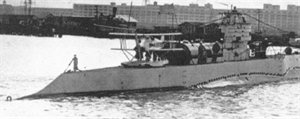American Aircraft-Carrying Submarine
 There's a fun article over at The New London Day today (annoying registration required starting tomorrow) on the aircraft-carrying tests done with the S-1 eighty years ago:
There's a fun article over at The New London Day today (annoying registration required starting tomorrow) on the aircraft-carrying tests done with the S-1 eighty years ago:"When the submarine force was still new the navy was searching for better designs to increase the vessel's range, durability and number of torpedoes it could carry. Congress had provided for the construction of a new class of submarines in 1916, to be “the best and most desirable and useful type of submarine which can be procured.” The first of this class, S-1, was built at the Fore River Shipbuilding Company at Quincy, Mass., a subcontractor for the Electric Boat Company which was still a New Jersey firm at that time. (Their subsidiary, New London Ship & Engine in Groton, known locally as NELSECO, created in 1911 for the purpose of constructing diesel engines, was not yet building submarines.) The keel was laid December 11, 1917 and the submarine was launched the following October, christened by the wife of Vice Admiral Emory S. Land, a naval architect who had played a major role in designing the new class.
"S-1 was commissioned June 5, 1920 with Lt. Cmdr. Thomas G. Berrien in command. The boat carried four officers and 34 enlisted men and was 219 feet in length, with a beam of 20 feet 8 inches and a surface displacement of 854 tons. She carried 12 torpedoes and had two diesel engines manufactured by NELSECO at Groton. Two screw propellers gave the boat a surface speed of 14 1/2 knots. Underwater she was powered by storage batteries which could propel her at 11 knots for a short period of time submerged.
"It was routine business as the S-1 operated out of New London and Groton in her early years, but soon another chapter of her career began. Following World War I, the Navy investigated the possibilities of submarines carrying scouting planes, and late in 1923 the S-1 was selected for these experiments. The boat was altered by adding a steel capsule abaft the conning tower, a large cylinder designed to hold a small collapsible seaplane. The plan was that the submarine would surface and the plane would be rolled out and assembled. To launch the plane, the sub submerged until the deck was awash and the aircraft could be airborne.
"First experiments used a Martin MS-1 scouting seaplane made of wood and fabric with a three-cylinder engine. This work was done at Hampton Roads, Va., in October 1923, using booms to erect the plane's structure. It was largely unsuccessful because it took too long to assemble the aircraft."
Read the rest of the story... before it goes behind The Day's "wall of inpenetrability".


2 Comments:
That boat is now part of the new "super" fleet of Iranian Submarines....lol
5/01/2006 11:15 AM
Check out the Japanese I-400. There's a great account of taking it to Hawaii up on the Web...
5/02/2006 6:52 PM
Post a Comment
<< Home